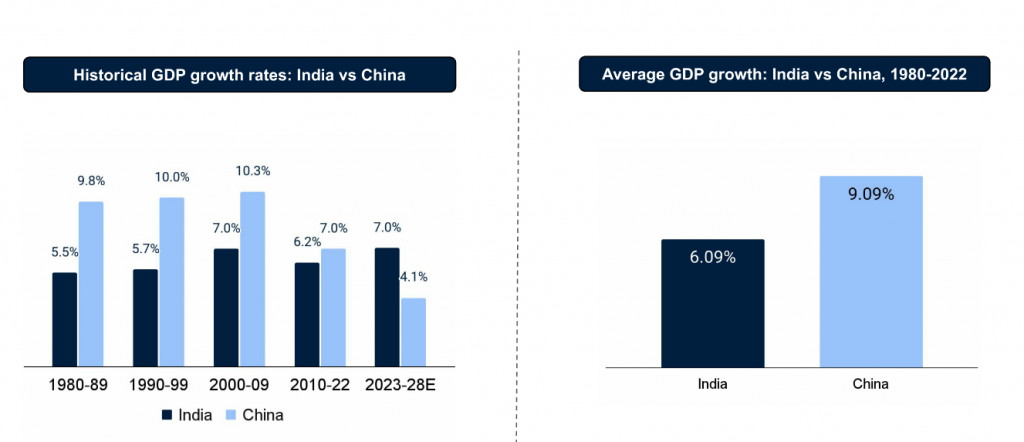A recent analysis compared the GDP growth rates of India and China over several decades. From 1980 to 1990, India grew at 5.5%, while China was nearly at 10%. In the following decade, India’s growth slightly increased to 5.7%, with China maintaining its 10% growth. Between 2000 and 2010, India saw a significant rise to 7%, but China continued at 10%. From 2010 to 2022, India grew at 6.2%, closely trailing China’s 7%. However, in the last six years, India’s estimated growth rate is 7%, while China is expected to slow down to 4%. This shift highlights India’s steady growth trajectory.

The Power of Steady Growth
India’s growth, although not as high as China’s peak growth rates, has been remarkably steady around the 7% mark. This consistency is vital as it compounds significantly over time. Using the Rule of 72, we can estimate that at a 7% growth rate, India’s economy will double in ten years. This means that if India’s GDP is near $4 trillion now, it could reach $8 trillion in a decade. Such growth positions India to potentially become the second or third-largest economy globally.
Impact on Stock Markets
A steady GDP growth rate positively impacts the stock markets. If GDP grows at 7% and inflation is around 5%, the nominal growth rate will be 12%. Historically, markets tend to outperform the GDP growth rate slightly. Thus, the Nifty index could see annual returns of about 13-14%. With effective stock selection, investors might achieve returns in the higher teens. Achieving anything above 12-13% post-tax returns over a long period is exceptional.
The Magic of Compounding
Compounding is a powerful tool in wealth creation. At a 13% post-tax return rate, investments double every four years. Over a 20-year period, this can result in a 32-fold increase in investment value. Such growth is achievable and has been surpassed by many in the past 20 years. Setting a target of 13% compounded returns for the next 20 years can potentially grow your investment 30 times. Continued investment and smart strategies can enhance this growth even further.
Path to Financial Independence
Achieving a 13% return rate over two decades can lead to financial independence. Starting early can lead to reaching this goal by your mid-forties or early fifties. Even starting late, but with larger investments, can yield significant results. The advantage lies in India’s strong growth trajectory. While growth rates may fluctuate between 5.5% to 8%, it is unlikely to drop to low levels, ensuring a steady growth path.
Making the Most of India’s Growth Potential
India’s economic setup provides a unique opportunity for growth. With a well-defined growth path, investors should capitalize on this potential. Staying committed to consistent investing and leveraging compounding can lead to substantial financial gains. The steady growth rate, combined with a robust stock market, provides a solid foundation for building wealth.

Disclaimers and disclosures : https://tinyurl.com/2763eyaz
If you have any questions, please write to support@weekendinvesting.com













